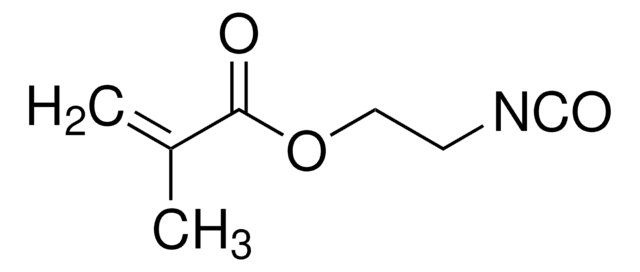305405
Octadecyl isocyanate
≥90%
동의어(들):
1-Isocyanatooctadecane, 1-Octadecyl isocyanate, ODI, Stearyl isocyanate, n-Octadecyl isocyanate
About This Item
추천 제품
vapor pressure
1 mmHg ( 154 °C)
분석
≥90%
refractive index
n20/D 1.45 (lit.)
bp
172-173 °C/5 mmHg (lit.)
mp
15-16 °C (lit.)
density
0.847 g/mL at 25 °C (lit.)
저장 온도
2-8°C
SMILES string
CCCCCCCCCCCCCCCCCCN=C=O
InChI
1S/C19H37NO/c1-2-3-4-5-6-7-8-9-10-11-12-13-14-15-16-17-18-20-19-21/h2-18H2,1H3
InChI key
QWDQYHPOSSHSAW-UHFFFAOYSA-N
유사한 제품을 찾으십니까? 방문 제품 비교 안내
애플리케이션
- surface of cellulose nanocrystals to promote interfacial filler/matrix interactions
- poly (2-hydroxyethyl methacrylate) (pHEMA) films, to investigate in vitro hemocompatibility assay using freshly drawn human whole blood
- cellulose nanocrystals (or whiskers) and microfibrillated cellulose (MFC)
신호어
Danger
유해 및 위험 성명서
Hazard Classifications
Acute Tox. 4 Dermal - Acute Tox. 4 Inhalation - Acute Tox. 4 Oral - Eye Irrit. 2 - Resp. Sens. 1 - Skin Irrit. 2 - Skin Sens. 1 - STOT SE 3
표적 기관
Respiratory system
Storage Class Code
6.1C - Combustible acute toxic Cat.3 / toxic compounds or compounds which causing chronic effects
WGK
WGK 1
Flash Point (°F)
300.2 °F - closed cup
Flash Point (°C)
149 °C - closed cup
개인 보호 장비
Eyeshields, Faceshields, Gloves, type ABEK (EN14387) respirator filter
시험 성적서(COA)
제품의 로트/배치 번호를 입력하여 시험 성적서(COA)을 검색하십시오. 로트 및 배치 번호는 제품 라벨에 있는 ‘로트’ 또는 ‘배치’라는 용어 뒤에서 찾을 수 있습니다.
이미 열람한 고객
자사의 과학자팀은 생명 과학, 재료 과학, 화학 합성, 크로마토그래피, 분석 및 기타 많은 영역을 포함한 모든 과학 분야에 경험이 있습니다..
고객지원팀으로 연락바랍니다.














